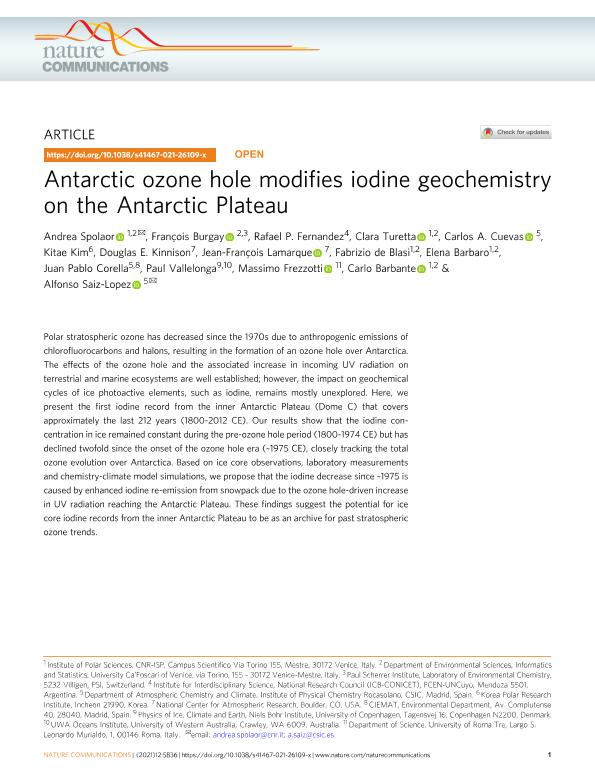Artículo
Antarctic ozone hole modifies iodine geochemistry on the Antarctic Plateau
Spolaor, Andrea; Burgay, François; Fernandez, Rafael Pedro ; Turetta, Clara; Cuevas, Carlos A.; Kim, Kitae; Kinnison, Douglas E.; Lamarque, Jean-François; de Blasi, Fabrizio; Barbaro, Elena; Corella, Juan Pablo; Vallelonga, Paul; Frezzotti, Massimo; Barbante, Carlo; Saiz López, Alfonso
; Turetta, Clara; Cuevas, Carlos A.; Kim, Kitae; Kinnison, Douglas E.; Lamarque, Jean-François; de Blasi, Fabrizio; Barbaro, Elena; Corella, Juan Pablo; Vallelonga, Paul; Frezzotti, Massimo; Barbante, Carlo; Saiz López, Alfonso
 ; Turetta, Clara; Cuevas, Carlos A.; Kim, Kitae; Kinnison, Douglas E.; Lamarque, Jean-François; de Blasi, Fabrizio; Barbaro, Elena; Corella, Juan Pablo; Vallelonga, Paul; Frezzotti, Massimo; Barbante, Carlo; Saiz López, Alfonso
; Turetta, Clara; Cuevas, Carlos A.; Kim, Kitae; Kinnison, Douglas E.; Lamarque, Jean-François; de Blasi, Fabrizio; Barbaro, Elena; Corella, Juan Pablo; Vallelonga, Paul; Frezzotti, Massimo; Barbante, Carlo; Saiz López, Alfonso
Fecha de publicación:
12/2021
Editorial:
Nature Publishing Group
Revista:
Nature Communications
ISSN:
2041-1723
Idioma:
Inglés
Tipo de recurso:
Artículo publicado
Clasificación temática:
Resumen
Polar stratospheric ozone has decreased since the 1970s due to anthropogenic emissions of chlorofluorocarbons and halons, resulting in the formation of an ozone hole over Antarctica. The effects of the ozone hole and the associated increase in incoming UV radiation on terrestrial and marine ecosystems are well established; however, the impact on geochemical cycles of ice photoactive elements, such as iodine, remains mostly unexplored. Here, we present the first iodine record from the inner Antarctic Plateau (Dome C) that covers approximately the last 212 years (1800-2012 CE). Our results show that the iodine concentration in ice remained constant during the pre-ozone hole period (1800-1974 CE) but has declined twofold since the onset of the ozone hole era (~1975 CE), closely tracking the total ozone evolution over Antarctica. Based on ice core observations, laboratory measurements and chemistry-climate model simulations, we propose that the iodine decrease since ~1975 is caused by enhanced iodine re-emission from snowpack due to the ozone hole-driven increase in UV radiation reaching the Antarctic Plateau. These findings suggest the potential for ice core iodine records from the inner Antarctic Plateau to be as an archive for past stratospheric ozone trends.
Palabras clave:
OZONE HOLE
,
IODINE RECYCLING
,
ANTARCTIC PLATEAU
,
DOME-C
Archivos asociados
Licencia
Identificadores
Colecciones
Articulos(ICB)
Articulos de INSTITUTO INTERDISCIPLINARIO DE CIENCIAS BASICAS
Articulos de INSTITUTO INTERDISCIPLINARIO DE CIENCIAS BASICAS
Citación
Spolaor, Andrea; Burgay, François; Fernandez, Rafael Pedro; Turetta, Clara; Cuevas, Carlos A.; et al.; Antarctic ozone hole modifies iodine geochemistry on the Antarctic Plateau; Nature Publishing Group; Nature Communications; 12; 1; 12-2021; 1-9
Compartir
Altmétricas



